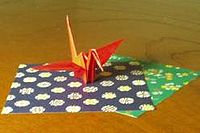
Origami paper
Encyclopedia

Origami
is the traditional Japanese art of paper folding, which started in the 17th century AD at the latest and was popularized outside Japan in the mid-1900s. It has since then evolved into a modern art form...
, the art of paper folding.
Kami
This paper is the easiest to find and cheapest to buy. It is also the most basic: kami, or koi paper. Kami is a thin, easy to fold paper. It is usually printed only on one side, with a solid color or pattern. These patterns can be as simple as a gradation from red to blue, or as complex as a multi-colored kimonoKimono
The is a Japanese traditional garment worn by men, women and children. The word "kimono", which literally means a "thing to wear" , has come to denote these full-length robes...
pattern of flowers and cranes with gold
Gold
Gold is a chemical element with the symbol Au and an atomic number of 79. Gold is a dense, soft, shiny, malleable and ductile metal. Pure gold has a bright yellow color and luster traditionally considered attractive, which it maintains without oxidizing in air or water. Chemically, gold is a...
foil embellishments. Kami comes in several sizes, but standard sizes include 75 × 75 mm (about 3 × 3 inches), 6-inch squares and 10-inch squares.
Origamido
Meaning the "Way of paper folding," this hand made paper is created by Micheal Lafosse specifically for origami. It is considered the best origami paper for its thinness and strength.Paper-backed foil
This medium is a slightly more expensive, flashier, paper that is good for retaining creases called paper-backed foil paper, Japanese foil, or simply foil. Foil paper is composed of a thin layer of foil adhered to an extremely thin sheet of paper. The most common colors are silver and gold, but any color is possible in foil paper including bright pink, blue and copper. In many multi-color packs, one sheet each of silver and gold paper is included. These are usually placed on the bottom end of the string if used in a thousand origami cranesThousand origami cranes
is a group of one thousand origami paper cranes held together by strings.An ancient Japanese legend promises that anyone who folds a thousand origami cranes will be granted a wish by a crane, such as long life or recovery from illness or injury...
.
Washi
WashiWashi
is a type of paper made in Japan. Washi is commonly made using fibers from the bark of the gampi tree, the mitsumata shrub , or the paper mulberry, but also can be made using bamboo, hemp, rice, and wheat...
is a thick hand-made paper, available commercially but very expensive. Washi is a long-fibred paper but is also very soft. It does not hold a sharp fold due to the extremely long and thick fibres of the pulp. Inclusions of flowers, leaves, grass, seeds, string, ribbon, and other small decorative items are common for washi, adding to the random and handmade appearance of the finished craft. Washi is also accepting of ink, making it easy to print upon. Printed washi has a uniquely shiny, uneven and occasionally transparent texture. In origami it is not as commonly used as kami paper.
Chiyogami
Chiyogami (literally "1000 generation paper") is an inexpensive alternative to washi paper. It is a traditional block-printed paper.Specialty fiber
For supercomplex origami, many folders choose a special, handmade, thin paper made of strong fibers, such as unryu, loktaLokta paper
Lokta paper known also as Nepali paper is made from the Lokta bush or Daphne bush, botanically known as Daphne bhoula or Daphne papyracea. The bush grows in the Himalayan mountainous region at 2,000 to 3,000 m . There are many different species of Daphne but only five of them are really suitable...
, saa, and abaca. However, to properly fold out of these papers, often methylcellulose
Methylcellulose
Methyl cellulose is a chemical compound derived from cellulose. It is a hydrophilic white powder in pure form and dissolves in cold water, forming a clear viscous solution or gel. It is sold under a variety of trade names and is used as a thickener and emulsifier in various food and cosmetic...
or methyl acetate
Methyl acetate
Methyl acetate, also known as MeOAc, acetic acid methyl ester or methyl ethanoate, is a carboxylate ester with the formula CH3COOCH3. It is normally a flammable liquid with a characteristic, pleasant smell like certain glues or nail polish removers. Methyl acetate has characteristics very similar...
is brushed over the paper and dried, to properly prepare the fibers for wet-folding
Wet-folding
Wet-folding is an origami technique developed by Akira Yoshizawa that employs water to dampen the paper so that it can be manipulated more easily. This process adds an element of sculpture to origami, which is otherwise purely geometric. Wet-folding is used very often by professional folders for...
.
Dollar bills and banknotes
Banknotes may be used to fold models as well. Banknotes are common media for folding as the subject in the center of the banknote, like George WashingtonGeorge Washington
George Washington was the dominant military and political leader of the new United States of America from 1775 to 1799. He led the American victory over Great Britain in the American Revolutionary War as commander-in-chief of the Continental Army from 1775 to 1783, and presided over the writing of...
, can make a striking appearance on the finished model.

